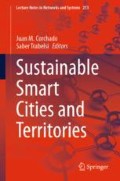Abstract
The internet of things (IoT) is a computing paradigm that expands every day along with the number of devices connected to the network including the home environment, that is why transmit information safely and be able to use all the computational capacity of the devices that compose it to analyze the generated data and find relevant information is one of the great challenges that it is tried to solve under the computational architecture proposed in the present article. The architecture proposed was tested in a laboratory environment with kitchen products information and the data obtained demonstrated that the architecture can solve the safe transmission using MQTT, storage in non-relational database and analysis of information with deep learning.
Access this chapter
Tax calculation will be finalised at checkout
Purchases are for personal use only
References
Stolpe, M.: The Internet of Things: opportunities and challenges for distributed data analysis. ACM SIGKDD Explor. Newsl. 18(1), 15–34 (2016)
Carbonell, J.G., Michalski, R.S., Mitchell, T.M.: An overview of machine learning. In: Machine Learning, pp. 3–23. Morgan Kaufmann (1983)
LeCun, Y., Bengio, Y., Hinton, G.: Deep learning. Nature 521(7553), 436–444 (2015)
Bonomi, F., Milito, R., Zhu, J., Addepalli, S.: Fog computing and its role in the internet of things. In: Proceedings of the First Edition of the MCC Workshop on Mobile Cloud Computing, pp. 13–16, ACM (2012)
Stergiou, C., Psannis, K.E., Kim, B.G., Gupta, B.: Secure integration of IoT and cloud computing. Future+ Gener. Comput. Syst. 78, 964–975 (2018)
Renart, E.G., Veith, A.D.S., Balouek-Thomert, D., de Assuncao, M.D., Lefèvre, L., Parashar, M.: distributed operator placement for IoT data analytics across edge and cloud resources (2019)
Yuan, X., He, P., Zhu, Q., Li, X.: Adversarial examples: attacks and defenses for deep learning. IEEE Trans. Neural Netw. Learn. Syst. 30, 2805–2824 (2019)
Jackson, K.R., et al.: Performance analysis of high performance computing applications on the amazon web services cloud. In: 2010 IEEE Second International Conference on Cloud Computing Technology and Science, pp. 159–168. IEEE November 2010
Krishnan, S.P.T., Gonzalez, J.L.U.: Building Your Next Big Thing with Google Cloud Platform: A Guide for Developers and Enterprise Architects. Apress (2015)
Barga, R., Fontama, V., Tok, W.H., Cabrera-Cordon, L.: Predictive Analytics with Microsoft Azure Machine Learning. Apress, Berkely (2015)
Naik, N.: Choice of effective messaging protocols for IoT systems: MQTT, CoAP, AMQP and HTTP. In: 2017 IEEE International Systems Engineering Symposium (ISSE), pp. 1–7. IEEE October 2017
Acknowledgments
This project is part of my master’s thesis in computational engineering at the University of Caldas and has contributed to the inter-institutional project between the university of caldas, the national university of Colombia and the company Mabe with hermes code 36715 entitled “Computational prototype for the fusion and analysis of large volumes of data in IoT environments (Internet of Things) from Machine Learning techniques and secure architectures between sensors, to characterize the behavior and interaction of users in a Connected Home ecosystem”.
Author information
Authors and Affiliations
Corresponding author
Editor information
Editors and Affiliations
Rights and permissions
Copyright information
© 2022 The Author(s), under exclusive license to Springer Nature Switzerland AG
About this paper
Cite this paper
Osorio, C.A.C., Ossa, L.F.C., Echeverry, G.A.I. (2022). Computational Architecture of IoT Data Analytics for Connected Home Based on Deep Learning. In: Corchado, J.M., Trabelsi, S. (eds) Sustainable Smart Cities and Territories. SSCTIC 2021. Lecture Notes in Networks and Systems, vol 253. Springer, Cham. https://doi.org/10.1007/978-3-030-78901-5_14
Download citation
DOI: https://doi.org/10.1007/978-3-030-78901-5_14
Published:
Publisher Name: Springer, Cham
Print ISBN: 978-3-030-78900-8
Online ISBN: 978-3-030-78901-5
eBook Packages: Intelligent Technologies and RoboticsIntelligent Technologies and Robotics (R0)

